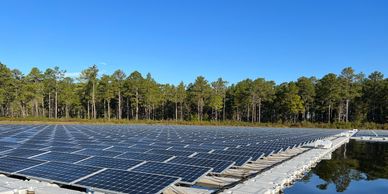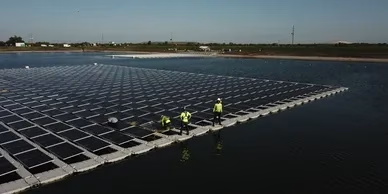Florida has reached a milestone in renewable infrastructure with D3Energy completing what is now the state’s largest floating solar-photovoltaic (FPV) installation. The array was installed on a utility-owned reservoir and marks a major step for construction-intensive FPV deployment. The project required advanced marine civil-works, floating-structure assembly, anchoring systems and electrical integration, underscoring the construction-industry complexity behind next-gen solar infrastructure.
Moreover, the completion signals growing demand for specialist contractors experienced in water-based solar platforms, logistics planning and heavy-duty foundation systems. Various construction phases included site preparation, pontoon installation, module stringing on floating platforms and grid-interconnect civil works. D3Energy’s track record in floating solar (including prior projects for utilities and universities) demonstrates the rising role of these systems in land-constrained jurisdictions.
Project Factsheet
Developer: D3Energy, Inc.
Location: Utility-owned reservoir, Florida, USA (largest FPV in the state)
Scale: Largest floating solar array in Florida to-date
Application: Floating PV modules mounted on pontoons and anchored systems
Construction scope: Marine works, floating foundations, module installation, power-plant connection
Significance: Demonstrates strong market for FPV in utility and water-asset contexts

Significance for Construction & Infrastructure
This floating solar array project exemplifies complex construction demands where infrastructure meets renewable energy innovation. Firstly, contractors must execute civil marine works: anchor systems, bulk-earth restraint, barge-supported installations and turbulence-resistant frameworks. Secondly, the floating nature adds structural-engineering nuances—pontoons, tilt mechanics, mooring design and material durability all require specialist skills. Consequently, the project invites heavy mechanical-electrical-plumbing (MEP) and electrical scope: large-scale cable trays, in-water risers, switch-gear skids and grid connection infrastructure. A similar approach can be seen in Enlight Energy’s $1.44 billion Snowflake A project in Arizona, where large-scale renewable-energy construction integrates both solar and storage systems, underlining the growing complexity and sophistication of next-generation clean-energy infrastructure.
Additionally, for regional construction firms, especially those targeting land-constrained or water-adjacent sites in Africa and elsewhere, this build shows how floating solar can unlock space, reduce land-use competition and open new contract categories. A parallel can be seen in the growth of large-scale land-based projects such as the 209 MWdc solar development in Texas awarded to SOLV Energy, which highlights how EPC standardization and PPA-backed structures are driving utility-scale renewable adoption. In turn, the supply-chain ripple-effect is meaningful: firms supplying steel fabrication, marine logistics, dry-dock assembly, and clean-energy integration will find opportunities across the FPV market. Ultimately, this Florida-based floating solar install signals a shift in infrastructure: not only ground-mounted solar farms but large-scale water-surface PV systems are now viable and construction-intensive, creating new pathways for industrial-construction firms.

